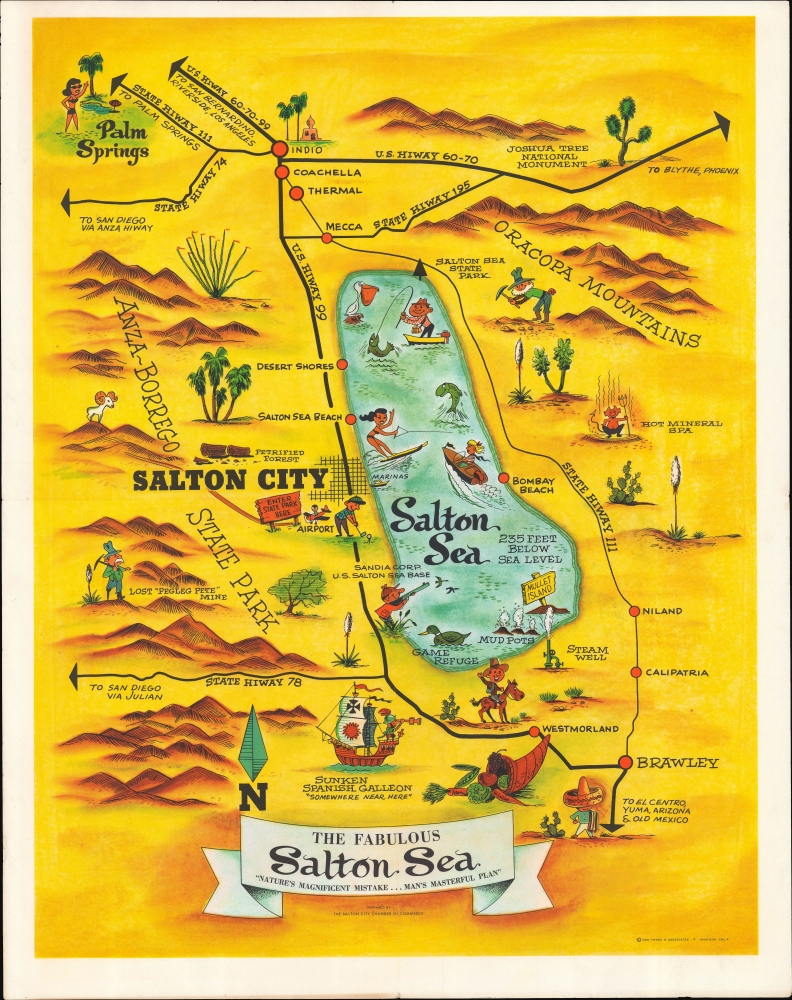This item has been sold, but you can get on the Waitlist to be notified if another example becomes available.
1958 Don Frank Pictorial Map of the Salton Sea and Environs, California
SaltonSea-frankdon-1958$375.00

Title
The Fabulous Salton Sea 'Nature's Magnificent Mistake... Man's Masterful Plan'
1958 (undated) 20.75 x 16 in (52.705 x 40.64 cm) 1 : 250000
1958 (undated) 20.75 x 16 in (52.705 x 40.64 cm) 1 : 250000
Description
An unrecorded c. 1958 pictorial map of the Salton Sea, prepared by Don Frank for the Salton City Chamber of Commerce. It presents the sea and Salton City as a desert paradise, a combination of accident and human endeavors to shape the environment. However, by the 1970s, inconsistent sea levels, increasing water salinity, and air pollution caused most of the city to be abandoned and drastically cut the sea's appeal as a recreational destination.
However, the environmental viability of the sea and surrounding communities was not sustainable. With no outlet for its waters, agricultural runoff caused it to become polluted and highly saline. Algae blooms proliferated, fish and birds died in droves (from botulism, among other ills), and since the 1980s, the lake has dried significantly, leaving a foul-smelling 'toxic dust' linked to asthma, cardiac disease, and lung cancer. In recent decades, efforts have been undertaken to mitigate the environmental harm and revive the lake's wildlife, with limited success.
A Closer Look
The map focuses on the Salton Sea and Salton City, highlighting their accessibility (via highways and airports) and recreational opportunities, including boating, golfing, fishing, and hot springs. References to local history, or rather, mythology, are made in the form of the likely apocryphal 'Sunken Spanish Galleon,' the remains of which are supposed to be laden with gold and pearls, and the lost 'Pegleg Pete' mine, a reference to the notorious trapper, explorer, conman, and horse thief Thomas L. 'Pegleg' Smith (1801 - 1886), who, after several years of unproductive prospecting in the Chocolate Mountains (now part of the Anza-Borrego State Park), convinced others that the mountains contained abundant gold reserves, selling them maps and claims of the fictitious diggings. The Salton Sea Base of the Sandia Corp. (Sandia National Laboratories) is noted south of Salton City. Nearby Palm Springs, Joshua Tree National Park, and the Coachella Valley appear at top, while communities surrounding the sea and links to more distant destinations (San Diego, Los Angeles, Phoenix, and 'Old Mexico') are indicated throughout.Salton City
Salton City was founded in the 1950s as a planned resort community by M. Penn Phillips and the Holly Corporation, an oil refinery and land developer from Texas. An initial spurt of development laid down a road grid, utilities, and other infrastructure. It attracted curiosity and visitors, including President Eisenhower, who played golf at the course seen here, and a celebrated annual boat race was established (boats could move faster on the lake's salty waters than freshwater). But the town never developed into a full-fledged resort akin to Palm Springs as its creators had envisioned. In the mid-late 1970s, a series of severe storms caused the sea level to rise, imperiling most of the town and leading to its abandonment (along with Bombay Beach on the sea's east coast). Shortly afterward, the environmental degradation of the Salton Sea greatly diminished its appeal to tourists. In recent years, the 'ghost towns' along the former shores of the Salton Sea have revived somewhat, as high home prices closer to Los Angeles have pushed homebuyers into the state's interior.The Other Great Salt Lake
One of the strangest episodes in the environmental history of the United States of America, the Salton Sea saw a dramatic rise and fall within the 20th century. Given its low elevation (235 feet below sea level at its lowest point), the area where the sea developed flooded periodically before the large-scale irrigation projects of the 20th century. But a 'permanent' sea was created accidentally in the early 1900s, especially when engineering works on the Colorado River failed, flooding the depression. Rather than dry up, as it would have naturally without further human intervention, the lake was continuously fed by runoff from surrounding farms. With the population of Southern California booming in the postwar period, the lake was presented as a recreation destination, combining desert heat and maritime recreation, including fishing, boating, bird spotting, hunting, and more. Resorts sprang up along the 'Salton Riviera', attracting tourist hordes, among them celebrities such as Frank Sinatra and Bing Crosby. At its height in the early 1960s, the Salton Sea State Recreation Area attracted as many visitors as Yosemite National Park.However, the environmental viability of the sea and surrounding communities was not sustainable. With no outlet for its waters, agricultural runoff caused it to become polluted and highly saline. Algae blooms proliferated, fish and birds died in droves (from botulism, among other ills), and since the 1980s, the lake has dried significantly, leaving a foul-smelling 'toxic dust' linked to asthma, cardiac disease, and lung cancer. In recent decades, efforts have been undertaken to mitigate the environmental harm and revive the lake's wildlife, with limited success.
Publication History and Census
This map was prepared by Don Frank and Associates, an advertising agency based in Anaheim, for the Salton City Chamber of Commerce. It is undated, but the sparse existing records of Don Frank and Associates all date to 1958, the same year Salton City was established. We are unaware of any other examples of it in institutional collections or on the market.Condition
Very good. Slight wear along centerfold and edge.

